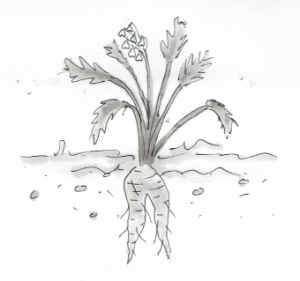Difference between revisions of "Twin Root"
From World of Entorais Wiki
Jump to navigationJump to searchm (layout) |
(layout and category) |
||
| Line 9: | Line 9: | ||
;Distribution:Sub-Tropical to sub-arctic forests. | ;Distribution:Sub-Tropical to sub-arctic forests. | ||
;Life Cycle:Annual, flowering in late summer to produce berries, which contain seeds dispersed by animal consumption. Twin Root can also be propagated from root cuttings. | ;Life Cycle:Annual, flowering in late summer to produce berries, which contain seeds dispersed by animal consumption. Twin Root can also be propagated from root cuttings. | ||
==Related Species== | |||
==Uses== | ==Uses== | ||
| Line 16: | Line 18: | ||
;Other:glue (root) | ;Other:glue (root) | ||
== | ==History== | ||
<!-- unique cultural notes--> | ;Cultural | ||
:<!-- unique cultural notes--> | |||
;Religious | |||
:<!-- unique religious notes--> | |||
==Stories== | ==Stories== | ||
| Line 26: | Line 31: | ||
[[Category:Flora]] | [[Category:Flora]] | ||
[[Category:Flower]] | |||
Latest revision as of 16:23, 7 August 2020
About
- Common Names
- Twin Root
- Classification
- Herbaceous, Flower, Fruit
- Description
- Twin root grows in shaded forest conditions, and is known for its distinctive double taproot. The flesh of the root is mucilaginous, and an excellent source of starch. The flower of this plant, a small cluster of pink drops, is often used a laxative and vermifuge. The small green berries produced as fruit are acrid and find some use as a spice.
Ecology
- Rarity
- Common
- Distribution
- Sub-Tropical to sub-arctic forests.
- Life Cycle
- Annual, flowering in late summer to produce berries, which contain seeds dispersed by animal consumption. Twin Root can also be propagated from root cuttings.
Related Species
Uses
- Cultivation
- wild
- Culinary
- edible (root), acrid spice (fruit)
- Medicinal
- laxative (flowers), vermifuge (flowers)
- Other
- glue (root)
History
- Cultural
- Religious
